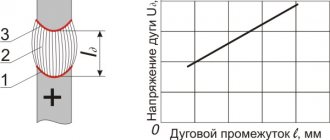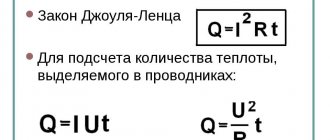The widespread use of electrical equipment in production and in a variety of electrical equipment in everyday life contributes to an increase in the level of electrical injuries, which is accompanied by electric shock. Electric current, under certain conditions, is a dangerous damaging factor that negatively affects the human body. In Fig. Below is a human hand injured by an electric shock.
Electrical injury to the hand
The effect of electric current on the human body
The mechanism of the negative impact of electric current on the human body is complex and diverse. As the current passes through the body, it has the following types of effects:
- Thermal effects, manifested by heating of the skin and tissue of internal organs, up to burns, leading to damage to blood vessels, nerve fibers and the brain and necrosis of tissue in parts of the body. When exposed to thermal effects, sharp functional disorders of human life support systems are observed, for example, sudden bleeding;
- Electrolytic effects, causing electrolysis of lymphatic fluid and decomposition of blood, disrupting the physico-chemical composition of all body tissues;
- Biological impact, expressed in disruption of the normal course of bioelectric processes inherent in living matter. The action of biocurrents that control the internal movements of the tissues of the human body is disrupted, which leads to involuntary unnatural convulsive contractions of the heart muscles and lungs. Living cells and tissues, with which the vitality of the organism is associated, become dangerously excited by the influence of current and may die;
- The mechanical action of an electric current, which causes separation and rupture of tissue due to the explosive formation of steam from blood and lymphatic fluid. The mechanical action provokes strong muscle contractions, up to the rupture of muscle fibers;
- Light effect, characterized by electroophthalmia after exposure to a powerful stream of ultraviolet radiation from an electric arc flash. External signs of electric shock include inflammation of the outer membrane of the eye.
In Fig. Below is an eye with signs of electroophthalmia.
Manifestations of electroophthalmia
Classification of species
Exposure to electric current has a negative impact on the human body and causes electrical injuries of varying degrees of complexity. Classification of types of damage when exposed to electric current on a person:
- Local electrical injuries – causing harm to the body of a local nature.
- General electrical injuries – harm to the body due to disruption of the stability of support systems and internal organs.
Local injuries
Violation of the integrity of the soft and bone tissues of the human body due to exposure to electric current or electric arc. This entails superficial damage to the skin, and sometimes to other soft tissues, as well as ligaments and bones.
Injuries of this nature are treatable until full or partial restoration of capacity. Deaths from local injuries are rare, and the cause of death is local damage to the body caused by electric current. Local injuries include:
- Electrical burn
- Electric sign
- Electroophthalmia (eye damage)
- Mechanical damage
- Electropigmentation (metalization) of the skin
Electrical burns are considered the most common electrical injury according to statistics on annual electrical accidents. Occurs in more than 60% of victims of electric current. About 85% are workers servicing electrical installations and electricians.
There are such types of electrical burns based on the influencing factors in case of electric shock:
- Current - occurs when voltage passes directly through the human body upon contact with live parts.
- Arc – occurs when an electric arc impacts the human body.
Electrical burns occur when working with low voltage on electrical installations, within 2 kV. High electrical voltages often provoke the formation of an electric arc or spark, causing burns.
Electrical burns affect about 38% of victims of electric current, in such situations these are 1st and 2nd degree burns, with voltages above 380 V - 3rd and 4th degrees.
- Grade 1 – causes redness on the skin.
- Stage 2 – the appearance of blisters.
- 3rd degree – necrosis of the entire skin.
- Grade 4 – charring of soft tissues.
Arc burns occur when working in electrical installations under voltage up to 10 kV due to short circuits during measurements with portable instruments or due to personnel errors. Damage occurs from a change in the electric arc or clothing that catches fire from it. The level of severity of harm caused to the body with this type of burn increases with increasing voltage of electrical installations. This type of burn accounts for 25% of burns.
In electrical installations, the cause of an electric arc can be:
- The approach of a person to live parts under voltage at such a distance that a breakdown is formed in the air gap between them.
- Damage to insulating protective equipment with which live parts come into contact under voltage.
- Error in operations with switching devices, due to the transfer of an electric arc to a person.
An electric sign is the appearance on the body of an oval or round spot of a gray or light yellow hue when exposed to thermal, chemical or mixed types of harm from electric current to the human body. The mark may be similar to the structure of the live part with which the victim had contact. In the affected area, the skin becomes rough and hard as the top layer of soft tissue dies. Electrocution is a minor injury and can be treated. Over time, the dead skin is renewed, the wound heals and the damaged area can only be seen by a small scar.
Electroophthalmia
The cause is exposure to an electric arc, producing strong ultraviolet radiation. The victim after irradiation, after 2-6 hours, has inflamed outer eye membranes, this condition is called electroophthalmia or, in simple terms, eye damage.
Symptoms include redness of the whites, increased tearing, partial loss of vision, headache, pain in the eyes in bright light, impaired transparency of the cornea, and constriction of the pupil. With serious exposure to ultraviolet radiation on the eyeball, treatment becomes more complicated and the time for full recovery increases.
Mechanical damage is the result of sudden uncontrolled convulsive contractions of muscle tissue when exposed to electric current passing through the human body. Such harm can occur mainly when working in electrical installations up to 1000 V when a person remains under high electrical voltage for a long time, and they are the cause of electrical shocks, since they are caused by current passing through the human body. The occurrence of such damage is quite rare, occurring in about 1% of victims from electric current. Injuries resulting from such an incident require long-term and serious treatment.
Electropigmentation (metalization) of the skin is a consequence of the effect of an electric arc on the skin, as a result of the penetration of molten metal particles into the soft tissues. Electric current affects the occurrence of heat flow and dynamic forces, and splashes of molten metal particles are formed that fly in all directions. Upon contact with unprotected areas of the body, they penetrate the upper skin layer.
Are common
This type of injury includes electric shock and electric shock, which cause a malfunction in the victim’s body of the main vital functions.
Electric shock - excitation of the tissues of the human body by a current discharge passing through it, is accompanied by intense contraction of muscle tissue, absent-mindedness, inattention and weakening of memory. An electric shock can result in either minor harm to the body or death. The threat of damage covers the entire body, due to disruption of the functioning of all vital organs and systems.
Degrees of condition of the human body after an electric shock:
- 1 – the person is conscious, but intense contraction of muscle tissue is observed;
- 2 – fainting, involuntary contraction of muscle tissue is observed;
- 3 – fainting, disruption of the heart, circulatory system and respiratory organs;
- 4 – cessation of functioning of the respiratory and circulatory organs, absence of vital signs.
Electric shock is a severe physiological reaction or injury to a person that occurs when an electric current passes through the human body. As a result, the healthy process in the respiratory organs and circulatory system is disrupted, and disruptions in metabolism are observed. After receiving an electric shock, the victim suffers from hypertension, lack of pain reactions, and an excited state.
Next, the process of slow reaction and exhaustion of the nervous system begins, blood pressure drops, heart rate increases, the respiratory system works with low activity, all this is accompanied by a depressive state. The condition can last from a few minutes to a day. Full recovery, with proper treatment, can occur in a fairly short time, but without medical intervention, death is possible.
Electrical injury concept
Premises according to the degree of danger of electric shock
The pathophysiological result of various effects of electric currents of varying strength on a person is electric shock, interpreted by GOST R IEC 61140-2000 “Protection against electric shock. General safety provisions..." as "...the physiological effect of electric current passing through the human body" (clause 3.1). The entire complex of changes in anatomical relationships in the body, dysfunctions of systems, organs and tissues, accompanied by a corresponding reaction of the body to the action of the current flowing through it, is usually called electrical trauma. In everyday speech, electrical trauma refers to electrical damage that is detected visually (burn) or by the body’s response of the following type:
- a feeling of a mechanical jolt or shock when an electric shock occurs;
- muscle cramps with painful effect;
- cardiac fibrillation, expressed in disruption of the functioning of the heart muscle, up to cardiac arrest and clinical death.
Note! The likelihood of a fatal electric shock falls into the category of implicit dangers, since there are no external attributes and signs of a real impending danger so that people could detect them in advance using their senses (for example, by analogy with a “hot-cold” or “dull-sharp” object).
The severity of electric shock, depending on the body's reaction, is divided as follows:
- First degree – muscle cramps, increased blood pressure, severe dizziness, but without loss of consciousness;
- The second degree is muscle cramps and loss of consciousness, which quickly returns, but the state of fear persists for a long time. Sometimes there is partial paralysis;
- The third degree is convulsions of muscle groups, leading to ruptures of soft tissues and dislocations of joints. Cardiac activity and breathing are impaired, and loss of consciousness occurs. Due to spasm of the vocal cords, the victim is unable to scream for help;
- Fourth degree – paralysis of the respiratory system, fibrillation of the heart muscle. Clinical death.
Important! Clinical death is the transition period that begins from the moment breathing and cardiac arrest stop. The victim of an electric shock has no signs of life, his heart is not working, and there is no breathing. However, in case of electric shock during the period of clinical death, the vital functions of the organs do not immediately fade away, which gives a chance to save a person’s life if appropriate assistance is provided in time - artificial respiration and cardiac massage.
Main types of damage
Types of electric shock to the human body:
- Thermal - associated with functional disorders and limitations - skin burns of varying degrees, damage and overheating of the cardiovascular system, cerebral cortex and other organs important for the functioning of the body, which is the cause of many functional disorders and disabilities.
- Electrolytic - affects blood and organic fluids in such a way that the process of their decomposition begins.
- Biological – causes irritation of muscle and nervous tissue, disruption of the heart and circulatory system, respiratory tract, provokes seizures and loss of consciousness. The result of this type of damage can be fibrillation of the heart muscle, failure of the respiratory organs, and death.
- Mechanical – entails rupture, separation or other similar damage to the soft tissues of the human body.
Classification of electrical injuries
Safety precautions when handling electric current
Electrical injuries are classified according to the following criteria:
- At the location of the electric shock injury;
In general, three types of traumatic injuries by currents of different origins are defined:
- Industrial electrical injuries - if a person was injured at work while working with equipment powered by electricity;
- Domestic injuries from electricity received in domestic conditions. Mostly, housewives and small children are susceptible to household electrical injuries. The main reasons are ignoring safety requirements when handling household appliances (washing machines, electric microwaves, irons);
- Natural electrical injuries – as a result of exposure to natural electricity. A classic example is a lightning strike, which is a discharge of atmospheric electricity.
In Fig. Below is a typical household electrical injury - a burn to the hand after an electric shock from a faulty electrical appliance.
Household electrical injury
- By the nature of the current (duration of exposure);
The temporary nature of the effect of current leads to two types of electrical injuries:
- Instant electrical injuries resulting from the action of an electric discharge for a short period of time (so-called electric shock). They have life-threatening injuries that require urgent medical attention;
- The chronic course of electrical injuries associated with the long-term and imperceptible influence of electric fields on a person. For example, personnel working near powerful high-voltage generators are susceptible to chronic electrical injuries. Symptoms of chronic damage are manifested in increased fatigue, tremors, high blood pressure, sleep disturbances, and memory impairment.
- Based on the nature of the lesion, the following were determined:
- Local electrical injuries, characterized by local (local) damage to a specific part of the body;
- General electrical injuries, which are extensive damage to the body as a result of electric current flowing through it. With general electrical injuries, cardiac and respiratory arrest may occur, leading to the clinical death of the injured person.
According to statistics, damage from electric shocks is distributed as follows:
- 20% of all cases are local electrical injuries;
- 25% – general injuries;
- 55% are mixed, in which local and general lesions of the body simultaneously appear.
Types of local electrical injuries
Local electrical injuries (hereinafter referred to as ME) are pronounced local violations of the anatomical integrity of tissues, including bone, caused by the damaging effects of electric current and arc. In most cases, ME is cured, and the functions of the victim’s organs are partially or completely restored. Cases of death from ME are quite rare, most often death occurs from a severe burn. The danger of ME and the complexity of treatment are assessed according to the following factors:
- location, nature and extent of tissue/tissue damage;
- the body's response to local damage.
Types of electric shock
The most typical types of ME are:
- Electrical burns, which are the result of thermal aggression of electric current as it flows through the body;
- Electrical signs (marks), represented by compacted areas of pale yellow color in the form of sharply defined spots on the skin of an electric shock victim. May appear as a cut or puncture wound, or as a charred area on the body. In the area with the electrical mark, the skin loses sensitivity;
- Metallization of the skin, caused by the penetration into the upper layers of human skin of microparticles of metal melted during the burning of an electric arc, or charged metal particles from baths with electrolyte;
Additional Information. When a short circuit occurs or the switch is turned off under load, a powerful heat flow is generated, which initiates the melting of the metal of the current-carrying elements. The dynamic forces that arise during a short circuit spray particles of molten metal, which fly around at high speed.
- Mechanical damage as a result of uncontrolled sharp convulsive muscle contractions during electric shock. There are dislocations of joints and ruptures of ligaments, ruptures of nerve fibers and blood vessels;
- Electroophthalmia.
Let's take a closer look at electrical burns as the most common ME.
Electrical burns
Electrical burns account for almost 60% of all MEs. According to the conditions of origin, electrical burns are divided into two categories of injuries:
- current (or contact) burn injuries that occur during the flow of electric current directly through the human body when a person comes into direct contact with current-carrying elements;
- arc burns caused by damage from an electric arc.
In Fig. Below is an example of an arc flash captured by a CCTV camera.
Arc Flash
Electrical burns occur in electrical installations with low voltage, not exceeding 2 kV. Higher voltages usually produce a spark or arc that causes burns. According to the severity of the injury, electric burns are divided as follows:
- I degree - minor damage to the upper layers of the skin epidermis, redness and swelling of the skin without blistering. The injury can be easily healed at home and sometimes does not even require treatment;
- II degree - along with the usual damage to the upper layer of the skin, blisters filled with yellowish exudate appear (in everyday life, blisters from a burn are simply called blisters). For small burn areas, inpatient treatment at home is quite sufficient;
- III degree - the skin is affected throughout its entire thickness with the development of necrosis, which does not allow its independent regeneration (necrosis of the skin and subcutaneous tissue);
- IV degree – complete necrotic damage to the skin, tissue, muscles, bones and tendons. Visually, the consequences are expressed by charred limbs and other parts of the body.
Important! Surgery is required to treat third and fourth degree burns.
In Fig. The following illustrates the extent of electrical burn injuries.
Severity of electrical burns
There is no need for current to pass through a person for arc burns to occur. When an arc burns, a powerful flow of thermal energy is generated, which can cause severe burns up to degrees III and IV.
Electric current, electrical injuries and electrical injuries Electrical injury refers to injury caused by an electric current or an electric arc. Electrical injuries are characterized by the following features: the body’s protective reaction appears only after a person comes under voltage, i.e., when the electric current is already flowing through his body; electric current acts not only at points of contact with the human body and on the path through the body, but also causes a reflex action, manifested in disruption of the normal activity of the cardiovascular and nervous systems, breathing, etc. A person can receive an electrical injury either through direct contact with live parts, and when affected by touch or step voltage, through an electric arc. Electrical injuries make up a small percentage compared to other types of industrial injuries, but they rank among the first in terms of the number of injuries with severe, and especially fatal, outcomes. The largest number of electrical injuries (60-70%) occurs when working on electrical installations with voltages up to 1000 V. This is explained by the wide distribution of such electrical installations and the relatively low level of electrical technical training of the persons operating them. There are significantly fewer electrical installations with voltages over 1000 V in operation, and they are serviced by specially trained personnel, which results in fewer electrical injuries. Causes of electric shock to a person The causes of electric shock to a person are the following: touching non-insulated live parts; to metal parts of equipment that are energized due to insulation damage; to non-metallic objects that are energized; shock voltage step and through the arc. Types of electric shock to humans Electric current flowing through the human body affects it thermally, electrolytically and biologically. Thermal action is characterized by heating of tissues, up to burns; electrolytic - decomposition of organic liquids, including blood; the biological effect of electric current is manifested in disruption of bioelectric processes and is accompanied by irritation and excitation of living tissues and muscle contraction. There are two types of electric shock to the body: electrical injuries and electrical shocks. Electrical injuries - these are local lesions of tissues and organs: electrical burns, electrical signs and electrometallization of the skin. Electrical burns occur as a result of heating of human tissue by an electric current flowing through it with a force of more than 1 A. Burns can be superficial, when the skin is affected, and internal, when deep-lying tissues of the body are damaged. According to the conditions of occurrence, contact, arc and mixed burns are distinguished. Electrical marks are gray or pale yellow callus-like spots on the surface of the skin at the point of contact with live parts. Electrical signs are usually painless and go away over time. Electrometallization of leather is the impregnation of the leather surface with metal particles when it is sprayed or evaporated under the influence of an electric current. The affected area of the skin has a rough surface, the color of which is determined by the color of the metal compounds that get on the skin. Electroplating of the skin is not dangerous and disappears over time, just like electrical marks. Metallization of the eyes poses a great danger. Electrical injuries also include mechanical damage as a result of involuntary convulsive contractions of muscles during the flow of current (ruptures of the skin, blood vessels and nerves, dislocations of joints, bone fractures), as well as electroophthalmia - inflammation of the eyes as a result of the action of ultraviolet rays of an electric arc. An electric shock is the stimulation of living tissues by electric current, accompanied by involuntary convulsive muscle contractions. Based on the outcome, electric shocks are conventionally divided into five groups: without loss of consciousness; with loss of consciousness, but without disturbances of cardiac activity and breathing; with loss of consciousness and disturbances in cardiac activity or breathing; clinical death and electric shock. Clinical, or “imaginary” death is a transitional state from life to death. In a state of clinical death, cardiac activity stops and breathing stops. The duration of clinical death is 6...8 minutes. After this time, the death of the cells of the cerebral cortex occurs, life fades away and irreversible biological death occurs. Signs of clinical death: cardiac arrest or fibrillation (and, as a result, absence of a pulse), lack of breathing, bluish skin, the pupils of the eyes are sharply dilated due to oxygen starvation of the cerebral cortex and do not respond to light. Electric shock - This is a severe neuro-reflex reaction of the body to irritation by electric current. In case of shock, deep disorders of breathing, blood circulation, nervous system and other body systems occur. Immediately after the action of the current, a phase of excitation of the body begins: a reaction to pain appears, blood pressure rises, etc. Then a phase of inhibition begins: the nervous system is exhausted, blood pressure decreases, breathing weakens, the pulse drops and increases, and a state of depression occurs. The state of shock can last from several tens of minutes to a day, and then recovery or biological death may occur. What determines the degree of action of electric current on the human body? The outcome of the injury also depends on the duration of the current flow through the person. As the length of time a person remains under voltage increases, this danger increases. The individual characteristics of the human body significantly influence the outcome of damage due to electrical injuries. For example, a non-releasing current for some people may be a threshold current for others. The nature of the action of a current of the same force depends on the mass of a person and his physical development. It has been established that for women the threshold current values are approximately 1.5 times lower than for men. The degree of action of the current depends on the state of the nervous system and the whole organism. Thus, in a state of nervous system excitement, depression, illness (especially diseases of the skin, cardiovascular system, nervous system, etc.) and intoxication, people are more sensitive to the current flowing through them. The “attention factor” also plays a significant role. If a person is prepared for an electric shock, then the degree of danger is sharply reduced, while an unexpected shock leads to more severe consequences. The path of current through the human body significantly influences the outcome of the injury. The danger of injury is especially great if the current, passing through vital organs - the heart, lungs, brain - acts directly on these organs. If the current does not pass through these organs, then its effect on them is only reflexive and the likelihood of damage is less. The most common current paths through a person, the so-called “current loops,” have been established. In most cases, the current circuit through a person occurs along the path from the right arm to the legs. However, loss of ability to work for more than three working days is caused by the flow of current along the hand-arm path - 40%, the current path right hand-legs - 20%, left hand-legs - 17%, other paths are less common. What is more dangerous - alternating or direct electric current? The danger of alternating current depends on the frequency of the current. Research has established that currents in the range from 10 to 500 Hz are almost equally dangerous. With a further increase in frequency, the threshold current values increase. A noticeable reduction in the risk of electric shock to humans is observed at frequencies above 1000 Hz. Direct current is less dangerous and its threshold values are 3 - 4 times higher than alternating current with a frequency of 50 Hz. However, when the DC circuit breaks below the perceptible threshold, sharp pain sensations occur, caused by the transient current. The statement about the lower danger of direct current compared to alternating current is valid for voltages up to 400 V. In the range of 400...600 V, the dangers of direct and alternating current with a frequency of 50 Hz are almost the same, and with a further increase in voltage, the relative danger of direct current increases. This is explained by the physiological processes of action on a living cell.General electrical injuries
General electrical injuries (hereinafter referred to as GE) are characterized by damage to two or more parts of the body or several internal organs at once. A direct threat to the life of the body is posed by disturbances in the normal functioning of various life support systems, including the functioning of the heart, brain and central nervous system.
The damaging potential of electric current depends on the following main factors:
- Type of current (alternating or direct) and frequency of current;
- Current strength and applied voltage;
- Current duration;
- Electric current paths;
It is customary to distinguish the following loops of the probable passage of current through the body (see figure below):
- pos. 1 – “hand-to-hand”;
- pos. 2 – “left arm and legs”;
- pos. 3 – “right arm-leg”;
- pos. 4 – “arms and legs”;
- pos. 5 – “leg-leg”;
- pos. 6 – “head-legs”;
- pos. 7 – “head-hand”;
- pos. 8 – “head-leg”.
Possible paths of current through the body
The most dangerous in terms of the degree of damage are considered to be the “head-arm” (pos. 7) and “head-leg” (pos. 8) loops, which are characterized by the passage of current through the brain and spinal cord. The least dangerous is the “leg-leg” loop (position 5), which practically does not affect vital organs.
- Resistance of the human body and the condition of the skin;
- Individual characteristics of the human body;
- Ambient air humidity.
Accidents associated with electric shock can be avoided if you strictly follow safety requirements when operating electrical equipment or do not use faulty household electrical appliances (for example, in everyday life they often neglect to carefully connect wires to sockets, using exposed wires, which can lead to electrical injury). Proper design, installation or repair of electrical devices ensures their safe operation.
In Fig. The following shows dangerous wiring connections to sockets.
Dangerous connection to sockets










